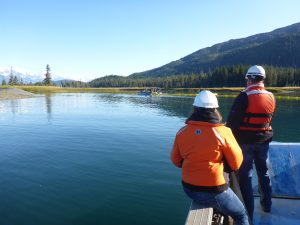Council voices support for full funding

The State of Alaska’s Oil and Hazardous Substances Release Prevention and Response Fund is in trouble. Funding for the prevention of spills is projected to be in a deficit by 2025.
Reduced pipeline flow contributes to shortfall
The amount of money going into the accounts ebbs and flows according to how many barrels flow through the pipeline. The amount of oil, which peaked in 1988 at 2.1 million barrels a day, has slowed considerably over the years and is now averaging just over 500,000 barrels a day. The revenues from the .95 cent surcharge on refined fuels were also originally overestimated. These factors, combined with lack of adjustment for inflation, have all resulted in the shortfall.
Response account used for contaminations other than oil and gas
Compounding the revenue problems, money from the response account has recently been used for sites that have been contaminated with per- and poly-fluoroalkyl substances, or PFAS, which is a group of potentially toxic human-made chemicals. It is possible that more funds from this account will be targeted for PFAS testing and remediation in future years. As a result, the fund balance is shrinking and Alaska’s ability to respond adequately to a major oil spill may be at risk.
Currently, crude and refined oil industries are the only contributors to the fund, even though the response account is used for other hazardous substances, such as the previously mentioned PFAS, acid, drilling mud, antifreeze and for remediation of junkyards containing a multitude of hazardous substances.
Effects of reduced funds
The director of the Alaska Department of Environmental Conservation’s Division of Spill Prevention and Response, Denise Koch, spoke with the Council during a recent meeting, voicing concerns about how this shortage could affect the State. She reported that her department is under pressure to reduce its budget, with seven positions eliminated for the upcoming fiscal year. Without an increase in revenue they may lose additional positions in future years.
Council supports stable and adequate funding
During a meeting in January, the Council reaffirmed its position on the 470 Fund, and passed a motion supporting:
- Revenue adjustments that include an increase in the .95 cent surcharge on refined fuel products.
- Inflation-proofing the fund.
- Broadening the tax base to collect revenue from non-oil industries that are served by the fund but do not currently contribute it.
Delays due to coronavirus
There was significant support for making the funding sustainable in both the Senate and House but the legislature recessed early due to coronavirus concerns and did not address the issue. The Council hopes to see a revenue adjustment during either a special session or next year.
How does this spill prevention and response fund work? Where does the money come from?
Commonly referred to as the “470 Fund” after the bill that created the law in 1986, it was meant to ensure adequate funds are on hand for immediate response to major spills, as well as for maintaining an effective prevention program. Designed to be self-sustaining, this fund pays for the State’s efforts to prevent spills of oil and other hazardous substances and the State’s ability to be prepared and respond quickly to spills when they happen.
To accomplish this, a 5-cents-per-barrel tax is paid to the State by the producers of the crude oil that flows through the Trans Alaska Pipeline System. The 470 fund is separated into two accounts: Four of the five cents go into an account for spill prevention, and one cent goes into an account to support response. Additionally, a .95 cent surcharge on refined fuel products is collected for spill prevention. Both accounts collect settlement penalties and interest earnings. Those who spill substances are also required to reimburse the State for those costs.